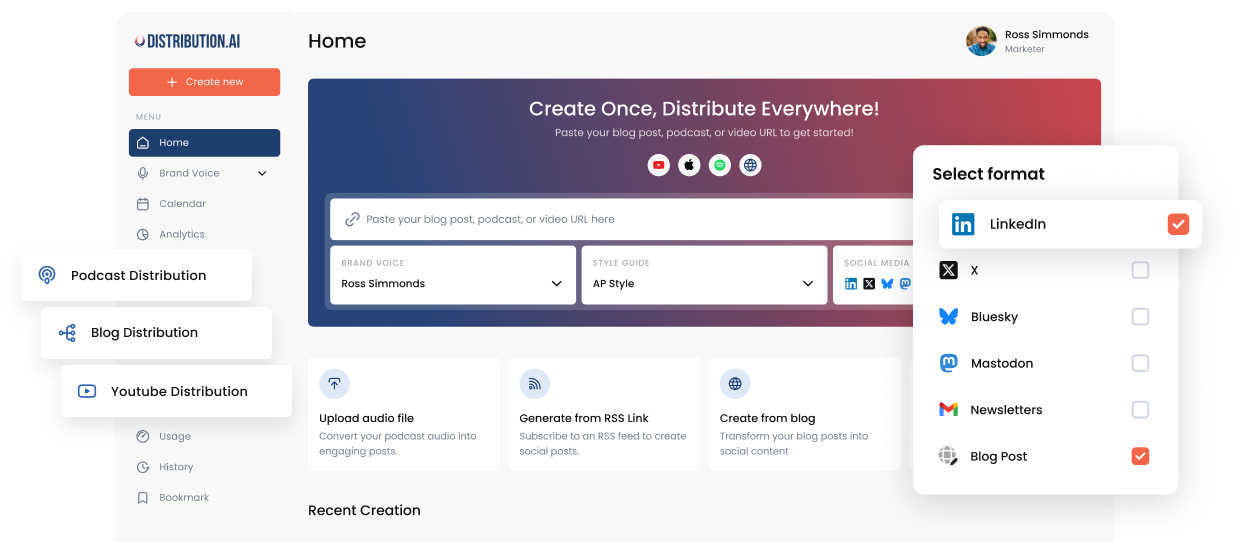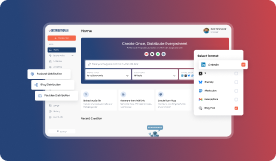Social Media Analytics Explained: How to Measure What Works & Improve Performance
Learn how to use social media analytics to track performance, find what content works, and refine your social media strategy with real data, not guesswork.
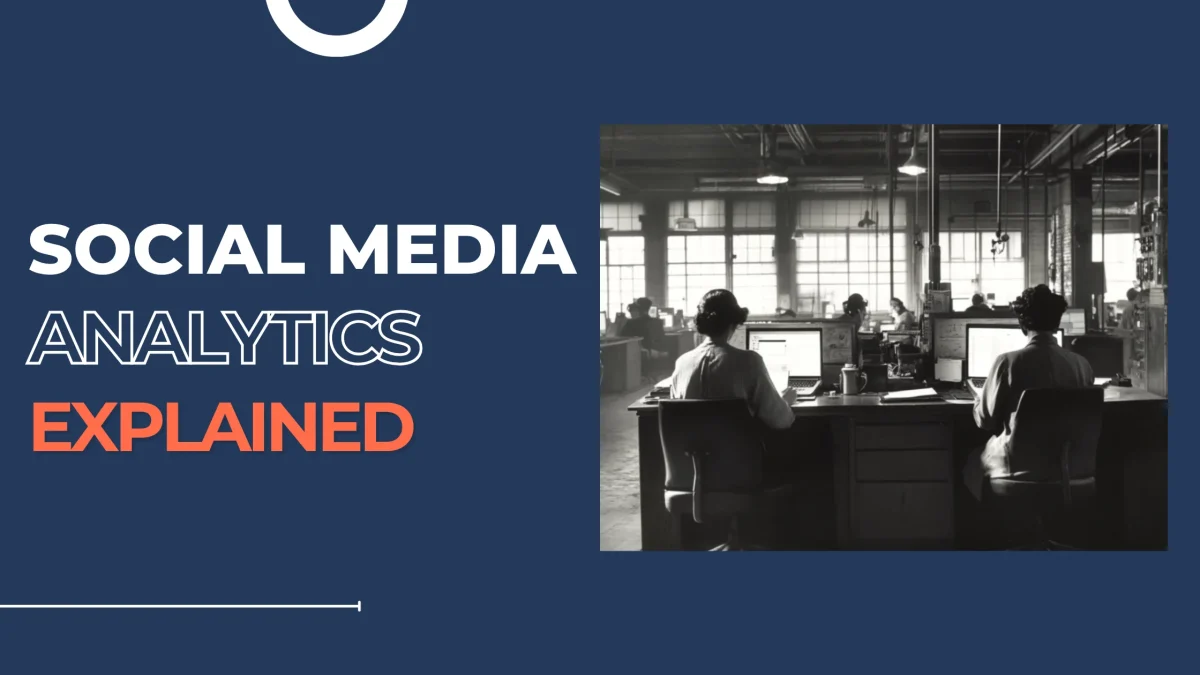
Social media success isn’t just about creating content anymore. It’s about understanding what actually works.
Every Facebook post, LinkedIn comment, and Instagram click leaves a trail of data. Hidden in that data are answers to questions most teams still guess at: what drives engagement, which platforms convert best, and how content performance connects to real business results.
That’s where social media analytics comes in. It turns raw data into insights you can act on. It shows what resonates with your audience, where your marketing spend performs best, and how to refine your strategy with evidence instead of assumptions.
Today, the brands that win are the ones reading the data well—spotting trends early, adapting fast, and using analytics to shape every decision from content creation to campaign timing.
What Is Social Media Analytics?
Social media analytics is the systematic analysis of data from social media channels to evaluate performance, audience behavior, and brand perception. It involves collecting relevant data—reach, engagement metrics, audience demographics, sentiment, and conversion actions—and using that information to improve social media marketing strategy.
Most teams use analytics to answer three critical questions:
- Which content formats perform best across multiple social media platforms?
- Which platforms deliver the highest engagement or conversion rates for goals— awareness, traffic, or sales?
- How does the audience respond—through clicks, shares, or sentiment trends?
- How do these interactions contribute to business outcomes such as revenue, retention, or brand equity?
Effective analytics combines data analysis, social listening, and competitor benchmarking to provide actionable insights into how a brand is perceived online, which topics resonate with the audience, and how to optimize social media campaigns for sustainable growth.
Types of Social Media Analytics
Descriptive analytics: To understand what happened
Descriptive analytics summarizes historical performance data across your social media platforms. It includes social metrics such as impressions, reach, engagement rate, follower growth, and post frequency.
Descriptive analytics helps you establish a baseline—how your social media accounts performed over a defined period and how that compares to previous cycles. Without descriptive analytics, you can’t diagnose or predict trends as it shows historical averages and patterns.
Diagnostic analytics: To find out why it happened
Diagnostic analytics examines the factors that caused specific performance outcomes—such as timing, creative format, platform algorithm shifts, or audience behavior changes.
For example, if engagement on LinkedIn drops, diagnostic analytics may reveal that post frequency decreased, content type shifted away from thought leadership, or competing content surged during that period.
Using these analytics helps you identify the cause-and-effect relationships that inform future decisions.
Predictive analytics: To predict what happens next
Predictive analytics involves using historical data analysis and statistical modeling to forecast future outcomes. For instance, predictive models can estimate how a campaign will perform based on past engagement rates or forecast audience growth if ad spend remains constant.
AI-driven tools also use predictive analytics to spot emerging trends, anticipate audience sentiment shifts, or recommend the best posting times.
This type of analytics allows marketers to act proactively — adjusting strategy before performance issues arise.
Prescriptive analytics: To decide the next steps
Prescriptive analytics goes beyond prediction. It recommends specific actions to achieve better outcomes. Using optimization models and real-time feedback loops, prescriptive analytics can suggest:
- Which content types to prioritize
- The optimal budget distribution across social media channels
- Adjustments to frequency or targeting to maximize campaign performance
For example, if predictive analysis shows that engagement will decline on Instagram, prescriptive tools may recommend reallocating resources toward LinkedIn, where your audience shows higher conversion intent.
This is the most advanced form of social media analytics, where data not only describes performance but actively guides decisions.
Real-time and cognitive analytics: To turn data into immediate action
Real-time analytics monitors live data streams to detect sudden changes—such as a spike in negative mentions or viral engagement—so teams can respond immediately.
Cognitive analytics combines AI, natural language processing, and automation to interpret unstructured data (comments, reviews, messages) and deliver context-aware recommendations. These capabilities turn analytics into a continuous feedback loop that keeps strategy agile and responsive.
Why Social Media Analytics Matters?
Social media analytics reduce guesswork, improve targeting, help allocate resources more effectively, and support decision-making.
Measures impact on business outcomes
Tracking social media efforts tells you the impact it creates on your business goals. Analytics connects posts, clicks, and impressions to social media KPIs such as conversions, cost per lead, and customer lifetime value. This alignment ensures that social investments are tied to measurable ROI.
Helps anticipate audience shifts
Analytics reveals emerging trends and sentiment patterns across social media networks.
For example, if analytics show a 40% increase in TikTok engagement around short product explainers, brands can shift ad spend from static posts to videos for higher click-through rates and conversions. Similarly, by monitoring brand sentiment and audience targeting data, teams can identify shifts in behavior and adapt campaigns before competitors.
Supports managing brand reputation in real time
With sentiment analysis and social listening, companies can identify negative mentions early and address them before they escalate. This protects brand reputation and improves customer trust.
Building data-driven strategies
Modern marketing teams integrate analytics with tools like Google Analytics and CRM systems to unify marketing data. This enables a complete view of the customer journey, linking social media campaigns to business outcomes.
How to Use Social Media Analytics?
Using social media analytics effectively starts with turning unstructured engagement data into structured insights that help you make decisions and refine strategies. The goal here is to collect the right social media metrics and KPIs, interpret them, connect them to measurable business outcomes, and create action plans to achieve the outcomes.
Here’s a complete analytics workflow to help you track essential metrics that contribute to improving social media performance.
Define clear objectives and match them with the right KPIs
The first step in using social media analytics effectively is clarity. If you don’t know what you’re trying to achieve, you won’t know what to measure. Start by defining what success means for your social channels. For example,
- If your goal is awareness, focus on reach, impressions, and engagement rate.
- If your goal is acquisition, track conversions, sign-ups, or purchases.
- If your goal is retention, monitor repeat engagement and audience sentiment over time.
Each goal needs one primary KPI that connects activity to a tangible business result. Instead of tracking every number, identify the few social media metrics that actually indicate progress toward your objective. This will help you decide where to double down and what to change next.
Track metrics that reflect real performance
Once your goals are clear, focus on metrics that directly show progress.
If you’re measuring awareness and visibility, prioritize reach, impressions, and engagement rate. For campaigns focused on pulling web traffic, look at click-through rate (CTR) and session quality—how long users stay and how deeply they interact with your site. If conversion is the goal, watch sign-ups, purchases, or form completions.
You can also consider sentiment analysis to understand the tone of brand mentions and user-generated comments, and track audience demographics and engagement patterns for deeper insights.
Combining these performance metrics provides both quantitative and qualitative insights, helping you understand why content performs and where optimization is needed.
Set up consistent tracking across channels
Use native analytics tools, such as Meta Business Suite, LinkedIn Analytics, YouTube Studio, and TikTok Analytics for channel-level insights and connect them to consolidated dashboards for consistent tracking.
For example, Distribution AI’s analytics dashboard gives you a unified view of all metrics across platforms. Whether you want to view top-performing posts on LinkedIn or check engagement rates on Instagram, you get it all on a single dashboard.
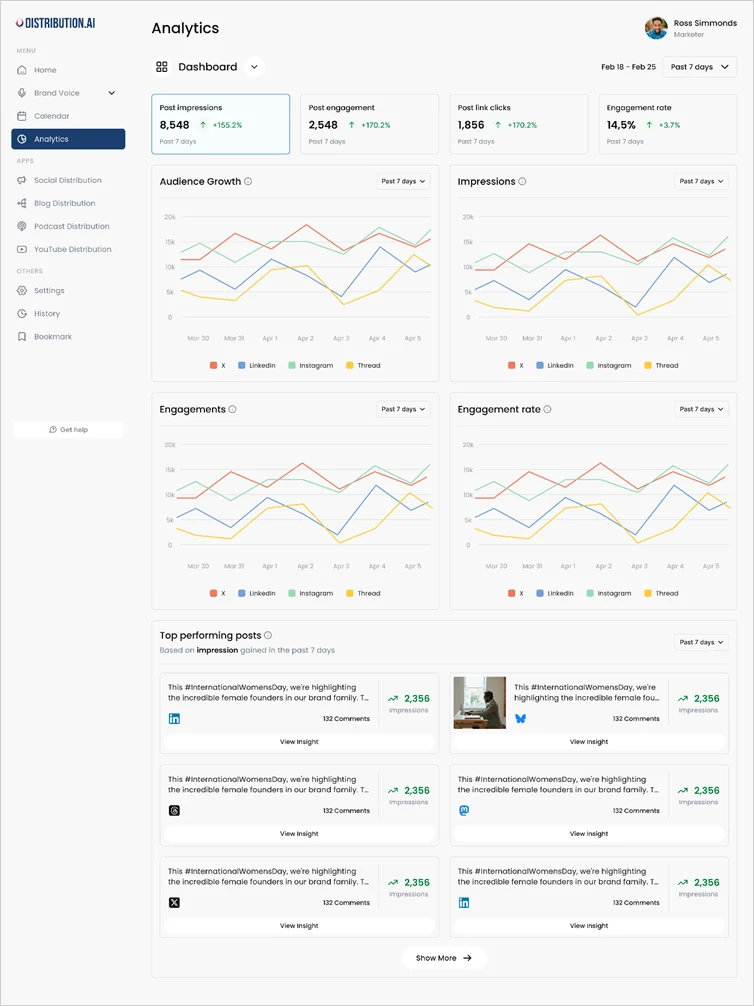
You can also implement UTM parameters (URL tags) to track traffic sources in Google Analytics. This ensures distinction between paid, organic, and referral traffic and ties every campaign to its original platform.
Suppose you find that LinkedIn drives fewer site visitors than Instagram but converts 3x more of them into qualified leads or demo sign-ups. These data points indicate allocating a larger share of paid budget and content resources toward LinkedIn, where engagement translates more directly into revenue, while continuing to use Instagram for top-of-funnel visibility.
Analyze data to derive meaningful insights
Pull actionable insights from social media analysis. Identify correlations between social media strategy and engagement spikes—such as post timing, format type, or caption length. Use historical data to establish benchmarks and competitive analysis to contextualize results.
Ask questions such as:
- Which post types maintain attention beyond the first few seconds?
- Do engagement rates rise when posts include user-generated content or polls?
- How does posting times affect visibility across regions or time zones?
Additionally, look for patterns like specific posts delivering higher saves and shares, carousels outperforming text posts in engagement, or response time improvements.
Turn insights into an actionable strategy
Use analytics to shape what you do next—refine content and social strategy, channel mix, and audience targeting.
If data shows short-form videos outperform static images, shift creative resources accordingly. If sentiment analysis indicates declining trust after a product update, adjust messaging to rebuild credibility. And if a campaign performs well on one platform but poorly on another, adapt the format instead of duplicating the same post for every channel.
Tools like Distribution AI make that adaptation seamless. It helps you repurpose a single piece of content for multiple platforms—turning a long post into a carousels for LinkedIn, quotes or infographics for Instagram, or a concise thread for X (formerly Twitter).
This approach ensures every social platform gets content tailored to its audience behavior and format conventions, significantly reducing the risk of underperformance or campaign failure.
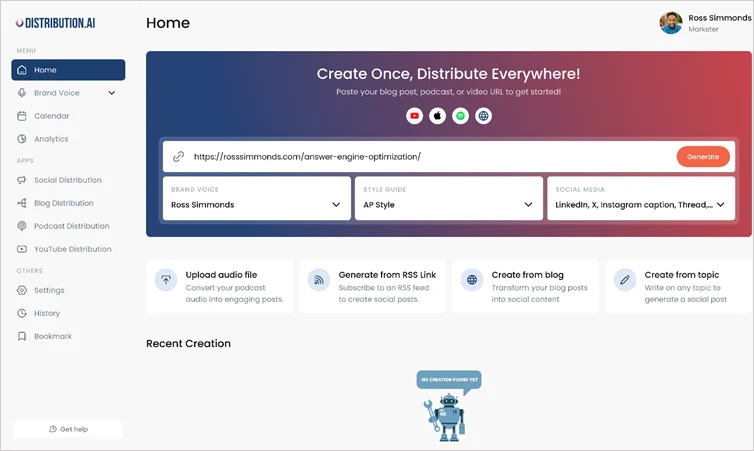
Also, use the findings to make data-driven adjustments. For instance,
- Reallocating budget toward social media channels that show stronger ROI
- Updating content strategy to emphasize formats with higher retention
- Refining audience targeting based on conversion and demographic data
Present social media findings, results, and recommendations
Translate analytics into insights that stakeholders understand. Build social reports that summarize KPIs, trends, and outcomes in clear visual formats. Highlight what happened, the results, why it matters, which channels contributed most, what improved, and where to focus next.
Make sure to set the reporting cadence. Weekly dashboards help track real-time insights and monthly reports for deep dives that uncover long-term shifts in target audience behavior and marketing campaigns ROI.
In practice, brands use social media automation to pull and compare data from multiple platforms—LinkedIn, Instagram, YouTube, and Facebook.
Let’s say, they found that Instagram Reels drove higher engagement but fewer conversions, while YouTube Shorts delivered consistent leads with lower engagement rates. By analyzing both sets of data, they can use Instagram to build awareness and YouTube to convert interest, aligning content purpose with channel performance.
Top 5 Social Media Analytics Tools
1. Distribution AI
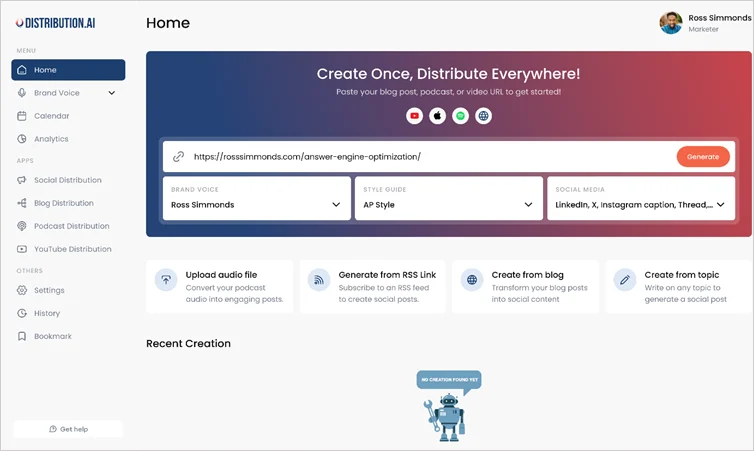
Distribution AI brings analytics and execution into one workflow. Instead of separating content planning, posting, and performance analysis, it brings them under one roof.
The platform analyzes your social content, helps you identify what performs best, and automatically repurposes content into platform-specific formats—such as LinkedIn carousels, X (Twitter) threads, or Instagram visuals. This ensures every post fits the channel it’s published on without diluting the message.
It also tracks how these repurposed assets perform over time, helping teams understand which content types sustain engagement and which decline quickly. Those insights inform future planning, so your next campaign begins with data instead of guesswork.
Distribution AI is best suited for teams managing content across several platforms who want to get a comprehensive view of all platform metrics on one dashboard and link analytics directly to distribution decisions.
2. Sprout Social
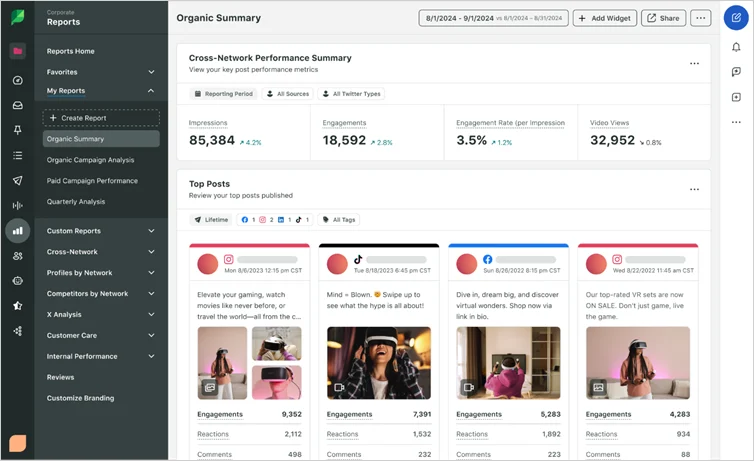
Best suited for enterprise teams, Sprout Social combines analytics, engagement, and collaboration in one platform. Its cross-channel dashboards display paid and organic performance side by side, helping teams understand how each contributes to broader goals.
The platform also offers professional reports and includes a unified inbox for managing interactions across social accounts. With built-in social listening, teams can track conversations, identify sentiment trends, and discuss findings directly alongside their performance data.
3. Locobuzz
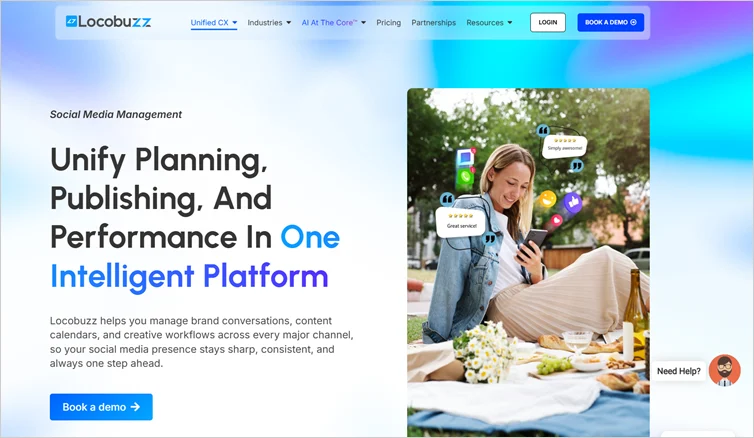
Locobuzz’s customer experience and social media platform blends analytics, listening, and workflow automation. It supports brand monitoring (mentions, keywords, competitor analysis), sentiment tracking, and trend detection across multiple platforms. It also helps you manage social interactions, offers auto-tagging, dashboards with customizable views, alerts for metric deviations, and integration with CRM systems.
4. Buffer
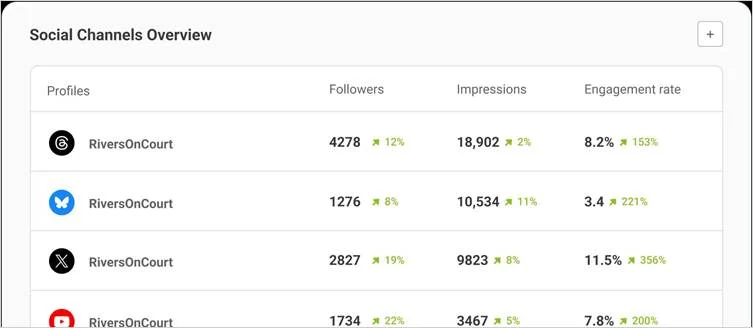
Buffer’s analytics suite, with its clean interface, focuses on the core metrics. It provides basic metrics such as engagement, reach, clicks, post shares, and follower growth across connected channels. It also supports UTM parameters, enabling tracking of social links in Google Analytics. Additionally, you can export reports and customize date ranges to drill into specific time periods.
5. Agorapulse
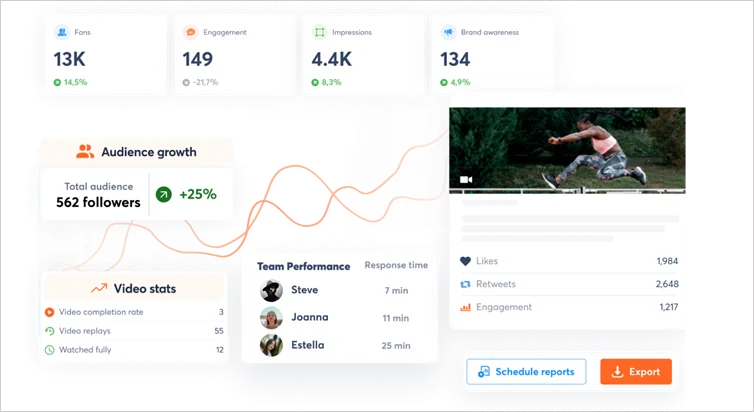
Agorapulse is a social media analytics and listening tool that offers cross-platform analytics that surface reach, engagement, and growth trends in one unified view. Its reports are exportable and customizable, so teams can tailor them for different stakeholders. Agorapulse also includes monitoring features, like tracking mentions, hashtags, and brand reputation across platforms.
Kickstart Tracking Social Media Analytics
Social media analytics is the foundation of smarter content decisions. When you understand which formats drive engagement, which platforms deliver conversions, and what the audience wants, you deliver strategic social posts that drive better outcomes.
Social media data analytics helps you close the loop between creation, distribution, and performance. It shows where your message resonates, when engagement peaks, and how to replicate success across multiple social media channels. Over time, this creates a solid content system where social media data fuels better strategy, and better strategy generates stronger data.
Tools like Distribution AI perfectly fit this workflow. It connects performance insights directly to execution. You can deep dive into what’s working and on which platform, generate channel-specific posts, schedule, and post them at the best times for maximum engagement—all from one platform.
Frequently Asked Questions
Promote, repurpose & distribute your content with AI
Start 15-Day Free Trial